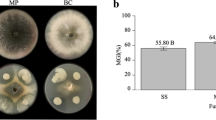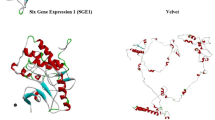Abstract
Onions can be damaged by Fusarium basal rot caused by the soilborne fungus Fusarium oxysporum f. sp. cepae (FOC). Control of this pathogen is challenging since there is limited genetic resistance in onion. The identification of molecules that inhibit this pathogen is needed. Antagonism screening showed Brevibacillus fortis NRS-1210 secreted antifungal compounds into growth medium. The spent growth medium, diluted 1:1, inhibited growth of FOC conidia after seven hours and killed 67–91% of conidia after 11 h. The spent medium also inhibited growth of propagules from F. graminearum, F. proliferatum, F. verticillioides and Galactomyces citri-aurantii. Full strength spent growth medium did not effectively kill FOC conidia and chlamydospores inoculated into a sand cornmeal mixture. In silico analysis of the B. fortis NRS-1210 genome indicated the biosynthetic clusters of several antibiotics. Fractionation of spent medium followed by reverse-phase liquid chromatography with tandem mass spectrometry analysis found that fractions with the most antifungal activity contained a combination of edeines A, B and F and no other recognized antibiotics. 1H NMR signals of the active fraction corresponded to edeine, a pentapeptide with broad spectrum antimicrobial activity which blocks translation in both prokaryotes and eukaryotes. Comparative genomics of Brevibacillus genomes shows edeine producers form a clade which consists of: Brevibacillus brevis, Brevibacillus formosus, ‘Brevibacillus antibioticus’, Brevibacillus schisleri, Brevibacillus fortis, and Brevibacillus porteri. This observation suggests edeine played an important role in the evolution and speciation of the Brevibacillus genus.




Similar content being viewed by others
References
Blin K et al (2017) antiSMASH 4.0—improvements in chemistry prediction and gene cluster boundary identification. Nucl Acids Res 45:W36–W41. https://doi.org/10.1093/nar/gkx319
Brayford D (1996) IMI descriptions of fungi and bacteria set 127. Mycopathologia 133:35–63
Chen S, Zhang M, Wang J, Lv D, Ma Y, Zhou B, Wang B (2017) Biocontrol effects of Brevibacillus laterosporus AMCC100017 on potato common scab and its impact on rhizosphere bacterial communities. Biol Control 106:89–98
Coşkuntuna A, Özer N (2008) Biological control of onion basal rot disease using Trichoderma harzianum and induction of antifungal compounds in onion set following seed treatment. Crop Prot 27:330–336
Cozzarelli NR (1977) The mechanism of action of inhibitors of DNA synthesis. Annu Rev Biochem 46:641–668
Cramer CS (2000) Breeding and genetics of Fusarium basal rot resistance in onion. Euphytica 115:159–166
Czajgucki Z, Andruszkiewicz R, Kamysz W (2006) Structure activity relationship studies on the antimicrobial activity of novel edeine A and D analogues. J Pept Sci 12:653–662
Czajgucki Z, Zimecki M, Andruszkiewicz R (2007) The immunoregulatory effects of edeine analogues in mice. Cell Mol Biol Lett 12:149
Dabire T, Bonzi S, Somda I, Legreve A (2016) Evaluation of the potential of Trichoderma harzianum as a plant growth promoter and biocontrol agent against Fusarium damping-off in onion in Burkina Faso. Asian J Plant Pathol 10:49–60
Dinos G, Wilson DN, Teraoka Y, Szaflarski W, Fucini P, Kalpaxis D, Nierhaus KH (2004) Dissecting the ribosomal inhibition mechanisms of edeine and pactamycin: the universally conserved residues G693 and C795 regulate P-site RNA binding . Mol Cell 13:113–124
Dunlap CA (2019) Taxonomy of registered Bacillus spp. strains used as plant pathogen antagonists. Biol Control 134:82–86. https://doi.org/10.1016/j.biocontrol.2019.04.011
Dunlap CA, Schisler DA, Bowman MJ, Rooney AP (2015) Genomic analysis of Bacillus subtilis OH 131.1 and coculturing with Cryptococcus flavescens for control of Fusarium head blight. Plant Gene 2:1–9
Dunlap CA, Bowman MJ, Rooney AP (2019) Iturinic lipopeptide diversity in the Bacillus subtilis species group—important antifungals for plant disease biocontrol applications. Front Microbiol 10:1794
Dunlap CA, Bowman MJ, Zeigler DR (2020) Promotion of Bacillus subtilis subsp. inaquosorum, Bacillus subtilis subsp. spizizenii and Bacillus subtilis subsp. stercoris to species status. Antonie van Leeuwenhoek 113:1–12. https://doi.org/10.1007/s10482-019-01354-9
Hettinger TP, Craig LC (1970) Edeine. IV. Structures of the antibiotic peptides edeines A1 and B1. Biochemistry 9:1224–1232
Hunter AR, Jackson RJ, Hunt T (1977) The role of complexes between the 40-S ribosomal subunit and Met-tRNAMetf in the initiation of protein synthesis in the wheat-germ system . Eur J Biochem 75:159–170
Jiang H et al (2015) Antifungal activity of Brevibacillus laterosporus JX-5 and characterization of its antifungal components. World J Microbiol Biotechnol 31:1605–1618
Jianmei C, Bo L, Zheng C, Huai S, Guohong L, Cibin G (2015) Identification of ethylparaben as the antimicrobial substance produced by Brevibacillus brevis FJAT-0809-GLX. Microbiol Res 172:48–56
Johnson ET, Dowd PF (2016) A quantitative method for determining relative colonization rates of maize callus by Fusarium graminearum for resistance gene evaluations. J Microbiol Methods 130:73–75
Johnson ET, Dunlap CA (2019) Phylogenomic analysis of the Brevibacillus brevis clade: a proposal for three new Brevibacillus species, Brevibacillus fortis sp. nov., Brevibacillus porteri sp. nov. and Brevibacillus schisleri sp. nov. Antonie van Leeuwenhoek 112:991–999
Johnson ET, Evans KO, Dowd PF (2015) Antifungal activity of a synthetic cationic peptide against the plant pathogens Colletotrichum graminicola and three Fusarium species. Plant Pathol J 31:316
Johnson ET, Proctor RH, Dunlap CA, Busman M (2018) Reducing production of fumonisin mycotoxins in Fusarium verticillioides by RNA interference. Mycotoxin Res 34:29–37
Jolley KA, Maiden MC (2010) BIGSdb: scalable analysis of bacterial genome variation at the population level. BMC Bioinform 11:595. https://doi.org/10.1186/1471-2105-11-595
Joo HJ, Kim H-Y, Kim L-H, Lee S, Ryu J-G, Lee T (2015) A Brevibacillus sp. antagonistic to mycotoxigenic Fusarium spp. Biol Control 87:64–70
Kumar S, Stecher G, Tamura K (2016) MEGA7: molecular evolutionary genetics analysis version 7.0 for bigger datasets. Mol Biol Evol.https://doi.org/10.1093/molbev/msw054
Kurylo-Borowska Z (1959) Antibiotical properties of the strain Bacillus brevis Vm4. Bull Inst Mar Trop Med Med Acad Gdansk 10:83–98
Kurylo-Borowska Z, Szer W (1972) Inhibition of bacterial DNA synthesis by edeine. Effect on Escherichia coli mutants lacking DNA polymerase I . Biochim Biophys Acta BBA Nucl Acids Protein Synth 287:236–245
Malathi S (2015) Biological control of onion basal rot caused by Fusarium oxysporum f. sp. cepae. Asian J Bio Sci 10:21–26
McGinnis S, Madden TL (2004) BLAST: at the core of a powerful and diverse set of sequence analysis tools. Nucl Acids Res 32:W20–W25. https://doi.org/10.1093/nar/gkh435
McKay A, Förster H, Adaskaveg J (2012) Toxicity and resistance potential of selected fungicides to Galactomyces and Penicillium spp. causing postharvest fruit decays of citrus and other crops. Plant Dis 96:87–96
Nguyen T, Tran-Nguyen L, Wright C, Trevorrow P, Grice K (2019) Evaluation of the efficacy of commercial disinfectants against Fusarium oxysporum f. sp. cubense race 1 and tropical race 4 propagules. Plant Dis 103:721–728
Ocamb C, Gent D (2019) Onion (Allium cepa)-Fusarium basal rot. In: Pscheidt J, Ocamb C (eds) Pacific northwest plant disease management handbook. Oregon State University Corvallis, Oregon. https://pnwhandbooks.org/node/3133. Accessed 26 Dec 2019
Pallazzini JM, Dunlap CA, Bowman MJ, Chulze SN (2016) Bacillus velezensis RC 218 as a biocontrol agent to reduce Fusarium head blight and deoxynivalenol accumulation in wheat: genome sequencing and secondary metabolite cluster profiles. Microbiol Res 192:30–36. https://doi.org/10.1016/j.micres.2016.06.002
Rajendran K, Ranganathan K (1996) Biological control of onion basal rot (Fusarium oxysporum f. sp. cepae) by combined application of fungal and bacterial antagonists. J Biol Control 10:97–102
Roncari G, Kurylo-Borowska Z, Craig LC (1966) On the chemical nature of the antibiotic edeine. Biochemistry 5:2153–2159
Rooney AP, Price NPJ, Ehrhardt C, Sewzey JL, Bannan JD (2009) Phylogeny and molecular taxonomy of the Bacillus subtilis species complex and description of Bacillus subtilis subsp. inaquosorum subsp. nov. Int J Syst Evol Microbiol 59:2429–2436. https://doi.org/10.1099/ijs.0.009126-0
Rout E, Tripathy P, Nanda S, Nayak S, Joshi RK (2016) Evaluation of cultivated and wild Allium accessions for resistance to Fusarium oxysporum f. sp. cepae. Proc Natl Acad Sci India Sect B Biol Sci 86:643–649
Schisler DA, Core AB, Boehm MJ, Horst L, Krause CR, Dunlap CA, Rooney AP (2014) Population dynamics of the Fusarium head blight biocontrol agent Cryptococcus flavescens OH182.9 on wheat anthers and heads. Biol Control 70:17–27. https://doi.org/10.1016/j.biocontrol.2013.11.011
Schisler DA, Boehm MJ, Paul PA, Rooney AP, Dunlap CA (2015) Reduction of Fusarium head blight using prothioconazole and prothioconazole-tolerant variants of the Fusarium head blight antagonist Cryptococcus flavescens OH 182.9. Biol Control 86:36-45. https://doi.org/10.1016/j.biocontrol.2015.04.002
Shimotohno K-W, Iida J, Takizawa N, Endo T (1994) Purification and characterization of arginine amidinohydrolase from Bacillus brevis TT02-8. Biosci Biotechnol Biochem 58:1045–1049
Song Z, Liu Q, Guo H, Ju R, Zhao Y, Li J, Liu X (2012) Tostadin, a novel antibacterial peptide from an antagonistic microorganism Brevibacillus brevis XDH. Bioresour Technol 111:504–506
Strong LC, McTavish H, Sadowsky MJ, Wackett LP (2000) Field-scale remediation of atrazine-contaminated soil using recombinant Escherichia coli expressing atrazine chlorohydrolase. Environ Microbiol 2:91–98
Tamura K, Nei M (1993) Estimation of the number of nucleotide substitutions in the control region of mitochondrial DNA in humans and chimpanzees. Mol Biol Evol 10:512–526
Taylor A, Vagany V, Barbara D, Thomas B, Pink D, Jones J, Clarkson J (2013) Identification of differential resistance to six Fusarium oxysporum f. sp. cepae isolates in commercial onion cultivars through the development of a rapid seedling assay. Plant Pathol 62:103–111
Taylor A, Vágány V, Jackson AC, Harrison RJ, Rainoni A, Clarkson JP (2016) Identification of pathogenicity-related genes in Fusarium oxysporum f. sp. cepae. Mol Plant Pathol 17:1032–1047
Türkkan M, Erper I (2014) Evaluation of antifungal activity of sodium salts against onion basal rot caused by Fusarium oxysporum f. sp. cepae. Plant Prot Sci 50:19–25
Westman EL, Yan M, Waglechner N, Koteva K, Wright GD (2013) Self resistance to the atypical cationic antimicrobial peptide edeine of Brevibacillus brevis Vm4 by the N-acetyltransferase EdeQ. Chem Biol 20:983–990
Yang X, Yousef AE (2018) Antimicrobial peptides produced by Brevibacillus spp.: structure, classification and bioactivity: a mini review. World J Microbiol Biotechnol 34:57
Acknowledgements
We are grateful for the excellent technical assistance of Mark Doehring, Victoria Nguyen, Jace Patacsil, and Heather Walker. We appreciate that Dr. Christopher Cramer provided the New Mexico 9 FOC strain. The mention of trade names or commercial products in this paper is solely for the purpose of providing specific information and does not imply recommendation or endorsement by the U. S. Department of Agriculture over other firms or similar products not mentioned. USDA is an equal opportunity provider and employer.
Funding
This study was supported by USDA CRIS Projects 5010-22410-019-00D and 5010-41000-161-00D.
Author information
Authors and Affiliations
Contributions
Study conception: EJ. All three authors performed research, analyzed data, and contributed to the writing of the manuscript.
Corresponding author
Ethics declarations
Conflict of interest
The authors declare no conflicts of interest in the manuscript.
Additional information
Publisher's Note
Springer Nature remains neutral with regard to jurisdictional claims in published maps and institutional affiliations.
Electronic supplementary material
Below is the link to the electronic supplementary material.
Rights and permissions
About this article
Cite this article
Johnson, E.T., Bowman, M.J. & Dunlap, C.A. Brevibacillus fortis NRS-1210 produces edeines that inhibit the in vitro growth of conidia and chlamydospores of the onion pathogen Fusarium oxysporum f. sp. cepae. Antonie van Leeuwenhoek 113, 973–987 (2020). https://doi.org/10.1007/s10482-020-01404-7
Received:
Accepted:
Published:
Issue Date:
DOI: https://doi.org/10.1007/s10482-020-01404-7




